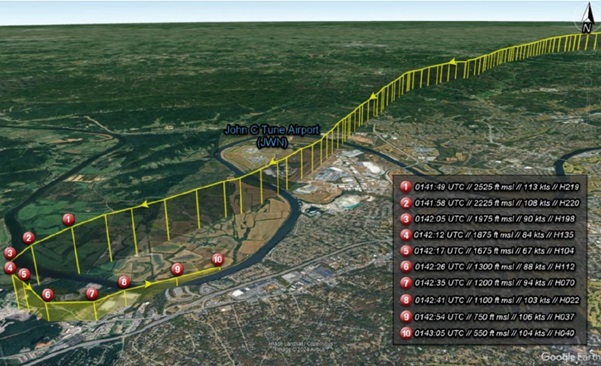Power loss preceded Bugatti crash
Scotty Wilson fought to control his one-of-a-kind Bugatti 100P replica after the forward propeller lost power just after liftoff Aug. 6, 2016. A factual report by the NTSB, and another report prepared by his team, offer a detailed account of the critical seconds leading up to a tragic loss in Oklahoma.
The team that worked with Wilson to build the replica of the 1930s air racer designed by famed car designer Ettore Bugatti, and built the only 100P ever to fly over the course of seven years, published its own report on the crash days after the NTSB issued a factual report. Both accounts are informed by the video footage captured by six action cameras that were on board with Wilson, a former fighter pilot with nearly 11,000 hours logged before his third and final flight in the replica of an airplane design that had never flown before.
“Now that the gruesome task of investigating the wreckage and the factual analysis of the cockpit video data have been done, the final conclusion is simple,” wrote Frank van Dalen, one of the team members and author of the team’s report. “Clutch slippage occurred on the forward engine, causing a loss of power at a critical stage of the flight, making it impossible for the pilot to recover despite the best possible efforts he made.”
The fateful flight was filmed by a chase helicopter, adding to the trove of information available to investigators. The Bugatti 100P was powered by two engines connected to a pair of counter-rotating propellers at the nose of the aircraft. The power trains were complex, including drive shafts, gear boxes, and clutches for each engine and propeller, and the team had experimented with different designs. Both the NTSB and the team, dubbed Le Rêve Blue, conducted detailed and meticulous analysis of the data including control positions and instrument readings captured by video cameras in the cockpit.
Just after liftoff, Wilson raised the landing gear and the rpm surged on the engine powering the forward propeller. Investigators estimate that the airplane reached a maximum altitude of 80 to 100 feet. Based on cockpit video of the control inputs, the team believes Wilson was very much aware of the power loss, and the critically low airspeed and altitude. The team concluded, in the report written by van Dalen, that Wilson made a conscious decision to attempt to clear the airport fence despite rapidly decaying airspeed:
“We do not know for a fact why he made that decision, but the most likely explanation is as follows. Had he dropped the nose sufficiently to maintain airspeed above 70 (knots), his descent rate probably would have made it impossible for him to clear the fence. He would have been forced to belly land inside the fence, to cross uneven ground as he traversed the inside road, ploughed through the fence and then traversed the outside road. The uneven ground and the fence itself would have likely broken the fuselage and exposed him to the whirling drive shafts—a dreadful scenario that he referred to on several occasions. In short, it is likely that he consciously reduced airspeed below the stall limit because he judged it as the lesser of two evils. He must have decided that he might be able to belly land safely in the field beyond the fence.”
As airspeed decayed below stall speed, the airplane rolled “uncommanded,” first to the right and then left through inverted, the NTSB report states:
“As the airplane rolled through 90 (degrees) of left bank, the pilot placed both hands on the control stick and commanded a right roll with a positive pitch attitude. The airplane continued to roll left, the nose dropped, and a green field came into view out of the front of the windscreen.”
The wreckage came to rest inverted in a bean field less than 2,000 feet from the runway’s displaced threshold, about 1,000 feet from the nearest paved surface. A post-crash fire destroyed much of the aircraft, though data was recorded from all six cockpit cameras, with complete recordings from five of them.
It is not clear why Wilson did not add more power to the rear engine, which might have resulted in a positive rate of climb, but van Dalen noted that clutch slippage problems that the team had encountered during the development and test program might have undermined Wilson’s confidence that the power train, particularly the chain drive, would have held up under the increased load. It was also a decision made during just a few seconds that elapsed between liftoff and the crash.
“In case Scotty had decided to accept the risk of a chain drive failure and had applied full throttle on the rear engine, my performance estimation shows that a climb rate of 390 ft/min would have resulted,” van Dalen wrote.




